DepthReading
Prehistoric stone workshop found in Dapingding site, Fujian Province
Summary: Dapingding site, situated in Minhou county Fujian Province, is an important site of Tanshishan Culture and Huangguashan Culture.
Prehistoric stone workshop found in Dapingding site, Fujian Province
From:Chinese Archaeology Writer: Date:2016-09-06
Dapingding site, situated in Minhou county Fujian Province, is an important site of Tanshishan Culture and Huangguashan Culture. During March and April in 2016, a salvage excavation of Dapingding site was conducted by Fujian Provincial Tanshishan Site Museum, uncovering about 20 square meters. A stone workshop was discovered. And two overlapped tombs and a group of grave goods were unearthed. Significant achievements have been made. However, the site was heavily destroyed, only western part of the cultural deposits remained Huangguashan cultural layers and Tanshishan cultural layers.
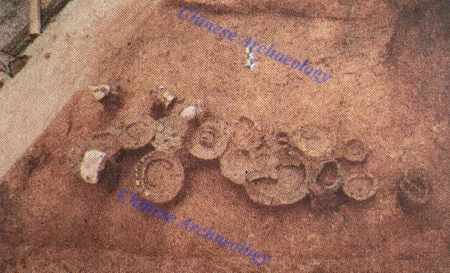
Tomb M1
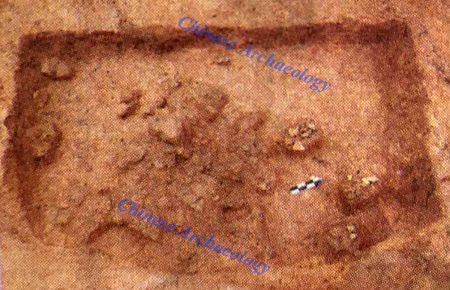
Tomb M2
Features
There are 2 tombs, both of which are vertical earthen shaft pit tombs with a rectangular plane. M1 broke M2. M1 is about 2.7 meters long remained and 1.8 meters wide. The burial objects in M1 were all in the northern part of the tomb chamber. There are 20 pieces of goods, part of which are under pebbles. Pottery includes clay pottery and sand-tempered pottery. Shapes of the pottery contain ding tripods, fu (caldrons), pan (plates), pots and so on. Besides, there is a stone adze found. M2 is 2.3 meters long remained and 1.5 meters wide. All the potteries from M2 are sand-tempered. The pottery shards were scattered all over the whole chamber. The recognizable shape of the pottery only was fu(caldron). And there is a stone adze found, too.
There are 11 ash pits dividing into 3 main kinds according to their inclusions. The first kind of pits has relatively much burnt soil, charcoals, pottery shards and flakes (such as H6). The second kind of pits contains certain amount of arranged pebbles (such as H8). The third kind has very rare inclusions (such as H2).
Among the pits, H1 is the most special one, the northern part of which is broken by H2. It is circular in plane with an about 1.1 meters diameter and 0.8 meters depth. There found some suspected features in it, such as post holes, hearths, rammed platforms and so on. The post hole is situated in the middle of the ash pit with an about 0.26 meters diameter. In the southern part of the ash pit, there is a rammed platform with relatively pure soil, an about 0.48 meters diameter and 0.2 meters thickness. On the platform, there is a painted fu (caldron). In the north of the platform, there might be a hearth. Within deposits of the hearth, there are relatively much charcoals and burnt soil. Unearthed artifacts include clay pottery fu (caldron) shards, spindle whirls and relatively plenty of stone raw materials and so on. According to the assemblage of the features and artifacts, H1 is probably a house foundation for cooking and handicraft manufacturing rather than living.
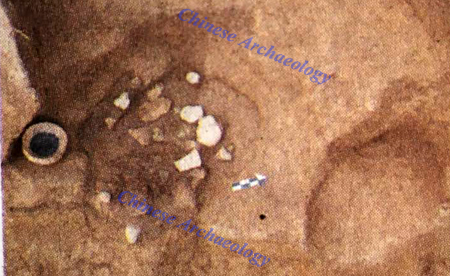
Ash pit H1
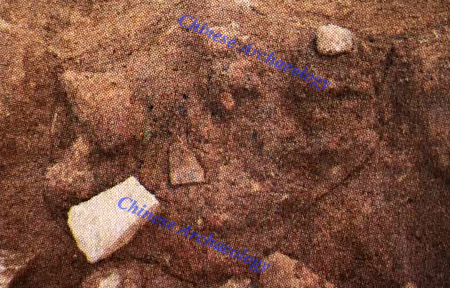
Fire remains unearthed from H1
Unearthed artifacts
According to raw materials of artifacts unearthed from Dapingding site, there are pottery artifacts and stone artifacts. The former ones include fu (caldrons), Spindle whorl and pottery stand and so on. The stone artifacts have adzes, arrowheads, hammer stones and stone balls and so on. Besides, there are plenty of flakes. Based on the stone assemblage found from the site including whetstones, raw materials, stone cores, flakes, semi-finished adzes, complete adzes and flake debris, these relics showed a complete stone artifact production process, which indicated the site should be a stone workshop.
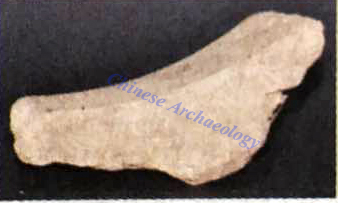
Whetstone unearthed from the site
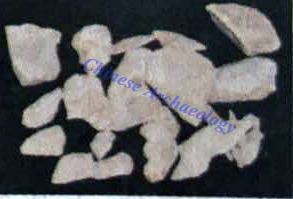
Waste stonr materials
Significances
Dapingding site has cultural remains mainly of Tanshishan culture and Huangguashan culture. The excavation is of great importance for research on prehistoric cultures in the lower range of Min River. First of all, complete stratigraphical data and rich remains of Dapingding site are the important finds after discoveries of Tanshishan site and Zhuangbianshan site in the lower range of Min River Region, providing new materials for refining the chronological and spacial distributions of prehistoric cultures in this region; Secondly, the unearthed painted fu (caldron) is the only complete painted pottery found in Huangguashan cultural periods so far, giving precious materials for research on Huangguashan culture. Last but not the least, plenty of stone artifacts including grinding stone, blanks, raw materials, semi-finished and finished stone tools unearthed in the site, showed production process of stone artifacts and prove that this site is an important stone workshop during Huangguashan cultural period. Taken results of previous archaeological survey in Yangli Basin into consideration, it's sure to state that there is a Huangguashan Cultural Settlement in Yangli Basin with stone manufacturing as its main characteristics. Therefore, this trial excavation will shed new light on stone-processing industry research of Huangguanshan Culture. (Translator: Ma Huanhuan)

Tomb M1

Tomb M2
Features
There are 2 tombs, both of which are vertical earthen shaft pit tombs with a rectangular plane. M1 broke M2. M1 is about 2.7 meters long remained and 1.8 meters wide. The burial objects in M1 were all in the northern part of the tomb chamber. There are 20 pieces of goods, part of which are under pebbles. Pottery includes clay pottery and sand-tempered pottery. Shapes of the pottery contain ding tripods, fu (caldrons), pan (plates), pots and so on. Besides, there is a stone adze found. M2 is 2.3 meters long remained and 1.5 meters wide. All the potteries from M2 are sand-tempered. The pottery shards were scattered all over the whole chamber. The recognizable shape of the pottery only was fu(caldron). And there is a stone adze found, too.
There are 11 ash pits dividing into 3 main kinds according to their inclusions. The first kind of pits has relatively much burnt soil, charcoals, pottery shards and flakes (such as H6). The second kind of pits contains certain amount of arranged pebbles (such as H8). The third kind has very rare inclusions (such as H2).
Among the pits, H1 is the most special one, the northern part of which is broken by H2. It is circular in plane with an about 1.1 meters diameter and 0.8 meters depth. There found some suspected features in it, such as post holes, hearths, rammed platforms and so on. The post hole is situated in the middle of the ash pit with an about 0.26 meters diameter. In the southern part of the ash pit, there is a rammed platform with relatively pure soil, an about 0.48 meters diameter and 0.2 meters thickness. On the platform, there is a painted fu (caldron). In the north of the platform, there might be a hearth. Within deposits of the hearth, there are relatively much charcoals and burnt soil. Unearthed artifacts include clay pottery fu (caldron) shards, spindle whirls and relatively plenty of stone raw materials and so on. According to the assemblage of the features and artifacts, H1 is probably a house foundation for cooking and handicraft manufacturing rather than living.

Ash pit H1

Fire remains unearthed from H1
According to raw materials of artifacts unearthed from Dapingding site, there are pottery artifacts and stone artifacts. The former ones include fu (caldrons), Spindle whorl and pottery stand and so on. The stone artifacts have adzes, arrowheads, hammer stones and stone balls and so on. Besides, there are plenty of flakes. Based on the stone assemblage found from the site including whetstones, raw materials, stone cores, flakes, semi-finished adzes, complete adzes and flake debris, these relics showed a complete stone artifact production process, which indicated the site should be a stone workshop.

Whetstone unearthed from the site

Waste stonr materials
Dapingding site has cultural remains mainly of Tanshishan culture and Huangguashan culture. The excavation is of great importance for research on prehistoric cultures in the lower range of Min River. First of all, complete stratigraphical data and rich remains of Dapingding site are the important finds after discoveries of Tanshishan site and Zhuangbianshan site in the lower range of Min River Region, providing new materials for refining the chronological and spacial distributions of prehistoric cultures in this region; Secondly, the unearthed painted fu (caldron) is the only complete painted pottery found in Huangguashan cultural periods so far, giving precious materials for research on Huangguashan culture. Last but not the least, plenty of stone artifacts including grinding stone, blanks, raw materials, semi-finished and finished stone tools unearthed in the site, showed production process of stone artifacts and prove that this site is an important stone workshop during Huangguashan cultural period. Taken results of previous archaeological survey in Yangli Basin into consideration, it's sure to state that there is a Huangguashan Cultural Settlement in Yangli Basin with stone manufacturing as its main characteristics. Therefore, this trial excavation will shed new light on stone-processing industry research of Huangguanshan Culture. (Translator: Ma Huanhuan)
Category: English
DepthReading
Key words:
